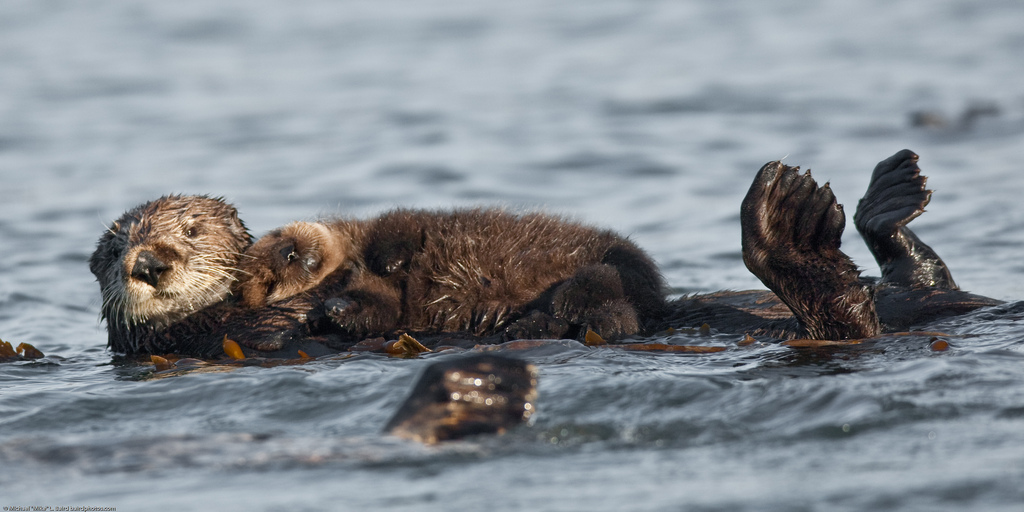
Mom may look like she’s taking a break, but she’s not. Photo courtesy of Mike Baird via Flickr, Creative Commons License.
Parenthood is both a universal and deeply personal experience. With my science background, I’m always contrasting what I understand as a biologist and what I feel as a mother. Sometimes the latest evolutionary/genetic/cognitive behavioral/comparative biology discovery reinforces my experiences (for example positive benefits of co-sleeping.) Other times it jars me out of a prejudice I wasn’t aware that I had.
For class I listened to a research presentation by a wildlife ecologist on how much food mother otters need to eat to support both themselves and their pups. Short take home message, for sea otters, lactating is really, really hard. In some cases, they nurse to death.
“They come in to the necropsy room, they’re skinny, emaciated.” said University of California Santa Cruz researcher Nicole Thometz when she described the unusually high numbers of adult female sea otters that would show up in the Santa Cruz marine wildlife morgue. The mother otters examined there all died from infection or injury, but the underlying cause was the extreme demands that nursing pups put on their bodies.
Sea otters are already among the hardest working marine mammals. Lacking an insulating layer of blubber, they have to eat 25 percent of their body weight each day to survive.
And mom needs to keep both herself and her baby alive. The first 3 weeks after giving birth, she spends most of her time caring for her newborn – no one organizes a meal delivery service, so she burns though any post pregnancy fat. Once she’s able to leave the pup alone at the surface, she dives for enough food to feed them both throughout lactation.
This goes on for about 6 months. By the end, she’s diving 12 hours a day. At this point, the pup is diving down with her, possibly catching its own food, but still nursing. This period is the hardest on mom energetically — pups at this age eat like growing teenage boys — but it’s also the most critical. Those last weeks are when the pup is mastering the skills it needs to survive.
As I diligently took notes (the assignment was to write up the presentation as a straight science news story) memories of my own nursing days played in my mind.
While on my first maternity leave, I attended a weekly new mothers meet up where we talked babies nonstop. Each session had a topic. For breastfeeding day, one of the moms I knew from our “Confident Homecoming” birthing classes let the bomb drop. She’d gotten very sick a week after giving birth and she had stopped producing milk. Her baby was on formula.
Although she seemed ambivalent, I remember feeling sadness for her.
Nursing, like a well-executed, drug-free birth plan, was one of the big goals I had prior to delivery. I remember clinging strongly to those goals because labor was this black hole beyond which I didn’t have a clue what was going to happen.
My son and I got to that other side by C-section. I didn’t dwell on the failed natural birth, but I took comfort in transitioning over to exclusive breastfeeding (one of the arguments against C-sections is that women are less likely to breastfeed) and was well versed in the biological benefits of feeding my baby naturally. It certainly saved us money on formula and helped me shed the pregnancy weight.
But looking back, I didn’t struggle to breast feed. I had 3 months of maternity leave, a flexible work schedule and access to a lactation room. I never got an infection and my sons didn’t have allergies. Contrast that to the stories of bleeding, changing diets and pumping through mastitis that I’ve heard from friends. Honestly, in such circumstances, I would have reached for the bottle.
Otter moms don’t have that option. In that way, they are a totem for the hard core nursing moms whose comments I read after nursing articles. But there’s a less uplifting side to otter nursing.
Once she reaches adulthood, the female sea otter is either pregnant or nursing. Being pregnant is her time off, so she had better put back on the weight before she gives birth, or else.
If she’s not physically up to nursing for the next six months, it makes no sense to start. She’s better swimming off, leaving her cute floating fur ball behind, and trying again. Thats one of reason why the Monterey Bay Aquarium has a rescue sea otter pup program.
Speculating on the parallels between humans and animals is fun and entertaining up to a point. Then you get to the very real consequences of what happens when a mother can’t feed her child. And that’s the point where I become very grateful that we’ve found substitutions to the natural way. Breast may still be best, but formula beats abandoning your baby.
There are countless studies that tout the benefits of breast feeding — preventing ear infections, decreasing chance allergies and lowering child obesity to name a few. If you take all the babies across America, many of those results would prove true.
On the personal level, I think back to the mother from my baby class, feeding her healthy baby from a bottle. Had she known about sea otter moms, I think she’d be grateful that she wasn’t one.
Want to read more, here’s the research paper:
Thometz, N.M., Tinker, M.T., Staedler, M.M., Mayer, K.A., and Williams, T.M. (2014) Energetic demands of immature sea otters from birth to weaning: implications for maternal costs, reproductive behavior, and population-level trends. Journal of Experimental Biology 217(12): 2053-2061.